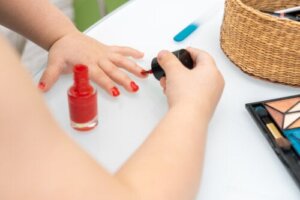Nail Polish on Children: Is It Safe?

One of the most frequent recreational activities in childhood is the use of nail polish for children. The strong and bright colors of nail polish generate significant attraction in the little ones, who then look happy and proud of their painted nails. However, these products contain some chemical substances that could cause adverse reactions in their delicate skins. Find out all about it.
Why is nail polish on children not recommended?
The high content of chemical substances in nail polishes can cause alterations in the nail plate:
- Peeling
- Dehydration
- Allergic contact dermatitis
- Modifications of the natural coloration due to the deposit of enamel pigments
- Irritative dermatitis due to the use of nail polish removers
It’s best not to use nail polish on children as a regular procedure, but to do so only occasionally. In other words, limit it to special occasions during the first years of life.
In addition, even if ingestion is minimal, children tend to put their fingers in their mouths considerably more often than adults. This further increases the risk of toxicity.

Allergic reactions to nail polishes
Early exposure to allergenic products can result in a risk of long-term sensitization. Some studies recently published by the journal Contact Dermatitis suggest that certain allergenic substances in nail polishes may be a risk for children.
Therefore, the less exposure children have to a product with allergenic potential, the better for their health.
In turn, another study by Pediatric Dermatology describes nail polish preservatives, called isothiazolinones, as notable contact allergens.
You might be interested in: Color Changes in Children’s Nails: What Do They Mean?
The use of nail polish removers in childhood
Procedures with permanent or semi-permanent nail polishes aren’t advised in children, as they contain toxic components such as acrylates and hydroquinone methyl ether (mequinol). Also, it’s important to remove nail polish with acetone-free products, as this chemical is very aggressive to the nail plates.
Although they may seem harmless, not all nail polishes are suitable for children. In fact, some can cause allergic reactions due to their high toxic content and others are quite harmful to the delicate skin of infants.
Most of the time, cosmetic nail products, such as acetones and polishes, are the care and hygiene products that cause a great deal of injury to children.
Read also: 4 Tricks for Cutting Children’s Fingernails
Aggressive components of nail polishes on children
Nail lacquers or nail polishes usually contain more or less chemical components, such as those listed below:
- Resins
- Nitrocellulose (responsible for forming the typical impermeable, smooth, hard, and shiny layer of the enamels)
- Plasticizers
- Adhesive polymers
- Solvents
- Formaldehyde (carcinogen that can also cause reproductive harm)
- Toluene (neurotoxin and skin irritant)
- Dibutyl phthalates (DBP)
The last three listed have a high power of toxicity, so more and more cosmetic brands are producing and marketing 3 Free nail polishes (free of these three chemical components).
Tips in case of using nail polish on children
If, despite the above, you decide to use nail polish on children, take into account the following recommendations:
- Don’t allow children to paint themselves or use cosmetic products without adult supervision.
- Always read container labels carefully before applying. According to long-established regulations, all products must provide a list of ingredients.
- Don’t put more than one coat of paint on each nail and always apply small amounts.
- If possible, choose polishes made for children that are water-based, have no toxic components, and are easy to remove.
- Opt for 3 Free polishes, which are free of toluene, formaldehyde, and phthalates. You can also find 4 Free (without formaldehyde resin) or 5 Free (without camphor).
- Be aware of possible allergic reactions to nail polish.
- When removing nail polish, use nail polish remover that doesn’t contain acetone, as it’s less irritating and toxic to the skin.
In addition to the above, it’s important to know that neither the Federal Trade Commission (FTC) nor the U.S. Food and Drug Administration (FDA) approves the nail polishes that are available on the market.

Final considerations regarding the use of nail polish on children
Using nail polish on children is a fun, creative activity, and is part of the process when they play dress up.
Although many of these products aren’t regulated, there are variants that are suitable for children that don’t contain harmful ingredients in their formulation. Even if they do contain them, the risk of toxicity is very low.
One of the most frequent recreational activities in childhood is the use of nail polish for children. The strong and bright colors of nail polish generate significant attraction in the little ones, who then look happy and proud of their painted nails. However, these products contain some chemical substances that could cause adverse reactions in their delicate skins. Find out all about it.
Why is nail polish on children not recommended?
The high content of chemical substances in nail polishes can cause alterations in the nail plate:
- Peeling
- Dehydration
- Allergic contact dermatitis
- Modifications of the natural coloration due to the deposit of enamel pigments
- Irritative dermatitis due to the use of nail polish removers
It’s best not to use nail polish on children as a regular procedure, but to do so only occasionally. In other words, limit it to special occasions during the first years of life.
In addition, even if ingestion is minimal, children tend to put their fingers in their mouths considerably more often than adults. This further increases the risk of toxicity.

Allergic reactions to nail polishes
Early exposure to allergenic products can result in a risk of long-term sensitization. Some studies recently published by the journal Contact Dermatitis suggest that certain allergenic substances in nail polishes may be a risk for children.
Therefore, the less exposure children have to a product with allergenic potential, the better for their health.
In turn, another study by Pediatric Dermatology describes nail polish preservatives, called isothiazolinones, as notable contact allergens.
You might be interested in: Color Changes in Children’s Nails: What Do They Mean?
The use of nail polish removers in childhood
Procedures with permanent or semi-permanent nail polishes aren’t advised in children, as they contain toxic components such as acrylates and hydroquinone methyl ether (mequinol). Also, it’s important to remove nail polish with acetone-free products, as this chemical is very aggressive to the nail plates.
Although they may seem harmless, not all nail polishes are suitable for children. In fact, some can cause allergic reactions due to their high toxic content and others are quite harmful to the delicate skin of infants.
Most of the time, cosmetic nail products, such as acetones and polishes, are the care and hygiene products that cause a great deal of injury to children.
Read also: 4 Tricks for Cutting Children’s Fingernails
Aggressive components of nail polishes on children
Nail lacquers or nail polishes usually contain more or less chemical components, such as those listed below:
- Resins
- Nitrocellulose (responsible for forming the typical impermeable, smooth, hard, and shiny layer of the enamels)
- Plasticizers
- Adhesive polymers
- Solvents
- Formaldehyde (carcinogen that can also cause reproductive harm)
- Toluene (neurotoxin and skin irritant)
- Dibutyl phthalates (DBP)
The last three listed have a high power of toxicity, so more and more cosmetic brands are producing and marketing 3 Free nail polishes (free of these three chemical components).
Tips in case of using nail polish on children
If, despite the above, you decide to use nail polish on children, take into account the following recommendations:
- Don’t allow children to paint themselves or use cosmetic products without adult supervision.
- Always read container labels carefully before applying. According to long-established regulations, all products must provide a list of ingredients.
- Don’t put more than one coat of paint on each nail and always apply small amounts.
- If possible, choose polishes made for children that are water-based, have no toxic components, and are easy to remove.
- Opt for 3 Free polishes, which are free of toluene, formaldehyde, and phthalates. You can also find 4 Free (without formaldehyde resin) or 5 Free (without camphor).
- Be aware of possible allergic reactions to nail polish.
- When removing nail polish, use nail polish remover that doesn’t contain acetone, as it’s less irritating and toxic to the skin.
In addition to the above, it’s important to know that neither the Federal Trade Commission (FTC) nor the U.S. Food and Drug Administration (FDA) approves the nail polishes that are available on the market.

Final considerations regarding the use of nail polish on children
Using nail polish on children is a fun, creative activity, and is part of the process when they play dress up.
Although many of these products aren’t regulated, there are variants that are suitable for children that don’t contain harmful ingredients in their formulation. Even if they do contain them, the risk of toxicity is very low.
All cited sources were thoroughly reviewed by our team to ensure their quality, reliability, currency, and validity. The bibliography of this article was considered reliable and of academic or scientific accuracy.
- Romita P, Foti C, Barlusconi C, Hansel K, Tramontana M, Stingeni L. Contact allergy to (meth)acrylates in gel nail polish in a child: An emerging risk for children. Contact Dermatitis. 2020 Jul;83(1):39-40. doi: 10.1111/cod.13503. Epub 2020 Mar 11. PMID: 32100300.
- Kullberg SA, Gupta R, Warshaw EM. Methylisothiazolinone in children’s nail polish. Pediatr Dermatol. 2020 Jul;37(4):745-747. doi: 10.1111/pde.14147. Epub 2020 Mar 20. PMID: 32198778.
- Reglamento (CE) Nº1223/2009 del Parlamento Europeo y del Consejo sobre productos cosméticos. [Internet] Disponible en: https://www.aemps.gob.es/cosmeticos-cuidado-personal/cosmeticos/faqs-reglamento-ce-1223-2009/
-
National Center for Biotechnology Information (2022). PubChem Compound Summary for CID 712, Formaldehyde. Retrieved May 1, 2022 from https://pubchem.ncbi.nlm.nih.gov/compound/Formaldehyde.
- Phthalates.[Internet] Disponible en: https://www.fda.gov/cosmetics/cosmetic-ingredients/phthalates
This text is provided for informational purposes only and does not replace consultation with a professional. If in doubt, consult your specialist.








